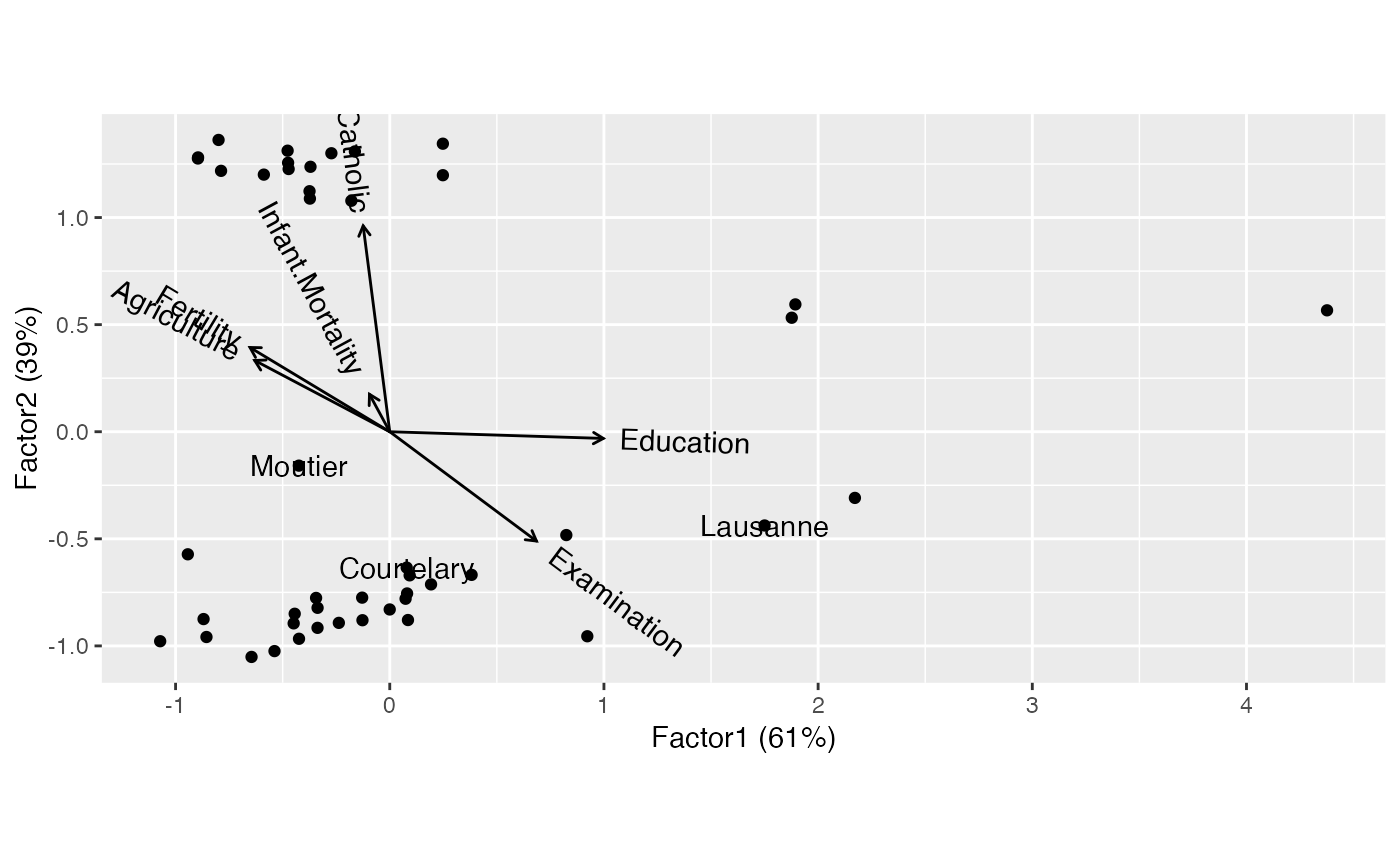These stats merely tell ggplot2::ggplot() which factor of an
ordination to pull data from for a plot layer. They are invoked internally
by the various geom_*_*() layers.
Usage
stat_rows(
mapping = NULL,
data = data,
geom = "point",
position = "identity",
subset = NULL,
elements = "active",
...,
show.legend = NA,
inherit.aes = TRUE
)
stat_cols(
mapping = NULL,
data = data,
geom = "axis",
position = "identity",
subset = NULL,
elements = "active",
...,
show.legend = NA,
inherit.aes = TRUE
)Arguments
- mapping
Set of aesthetic mappings created by
aes(). If specified andinherit.aes = TRUE(the default), it is combined with the default mapping at the top level of the plot. You must supplymappingif there is no plot mapping.- data
The data to be displayed in this layer. There are three options:
If
NULL, the default, the data is inherited from the plot data as specified in the call toggplot().A
data.frame, or other object, will override the plot data. All objects will be fortified to produce a data frame. Seefortify()for which variables will be created.A
functionwill be called with a single argument, the plot data. The return value must be adata.frame, and will be used as the layer data. Afunctioncan be created from aformula(e.g.~ head(.x, 10)).- geom
The geometric object to use to display the data for this layer. When using a
stat_*()function to construct a layer, thegeomargument can be used to override the default coupling between stats and geoms. Thegeomargument accepts the following:A
Geomggproto subclass, for exampleGeomPoint.A string naming the geom. To give the geom as a string, strip the function name of the
geom_prefix. For example, to usegeom_point(), give the geom as"point".For more information and other ways to specify the geom, see the layer geom documentation.
- position
A position adjustment to use on the data for this layer. This can be used in various ways, including to prevent overplotting and improving the display. The
positionargument accepts the following:The result of calling a position function, such as
position_jitter(). This method allows for passing extra arguments to the position.A string naming the position adjustment. To give the position as a string, strip the function name of the
position_prefix. For example, to useposition_jitter(), give the position as"jitter".For more information and other ways to specify the position, see the layer position documentation.
- subset
An integer, logical, or character vector indicating a subset of rows or columns for which to render graphical elements. NB: Internally, the
subsetwill be taken from the rows of the fortified 'tbl_ord' comprising rows from only one of the matrix factors. It is still possible to pass a formula to thedataparameter, but it will act on the fortified data before it has been restricted to one matrix factor.- elements
Character vector; which elements of each factor for which to render graphical elements. One of
"all"(the default),"active", or any supplementary element type defined by the specific class methods (e.g."score"for 'factanal', 'lda_ord', and 'cancord_ord' and"intraset"and"interset"for 'cancor_ord').- ...
Additional arguments passed to
ggplot2::layer().- show.legend
logical. Should this layer be included in the legends?
NA, the default, includes if any aesthetics are mapped.FALSEnever includes, andTRUEalways includes. It can also be a named logical vector to finely select the aesthetics to display.- inherit.aes
If
FALSE, overrides the default aesthetics, rather than combining with them. This is most useful for helper functions that define both data and aesthetics and shouldn't inherit behaviour from the default plot specification, e.g.borders().
Value
A ggproto layer.
Biplot layers
ggbiplot() uses ggplot2::fortify() internally to produce a single data
frame with a .matrix column distinguishing the subjects ("rows") and
variables ("cols"). The stat layers stat_rows() and stat_cols() simply
filter the data frame to one of these two.
The geom layers geom_rows_*() and geom_cols_*() call the corresponding
stat in order to render plot elements for the corresponding factor matrix.
geom_dims_*() selects a default matrix based on common practice, e.g.
points for rows and arrows for columns.
See also
Other biplot layers:
biplot-geoms,
biplot-stats
Examples
# FA of Swiss social data
swiss_fa <-
ordinate(swiss, model = factanal, factors = 2L, scores = "regression")
# active and supplementary elements
get_rows(swiss_fa, elements = "active")
#> Factor1 Factor2
head(get_rows(swiss_fa, elements = "score"))
#> Factor1 Factor2
#> Courtelary 0.07912746 -0.6344915
#> Delemont -0.17926953 1.0783941
#> Franches-Mnt -0.58784929 1.2004233
#> Moutier -0.42433417 -0.1583409
#> Neuveville 0.38211185 -0.6682790
#> Porrentruy -0.37286722 1.0884740
# biplot using element filters and selection
# (note that filter precedes selection)
ggbiplot(swiss_fa) +
geom_rows_point(elements = "score") +
geom_rows_label(aes(label = name), elements = "score", subset = c(1, 4, 18)) +
scale_alpha_manual(values = c(0, 1), guide = "none") +
geom_cols_vector(aes(label = name))
